Global industry overview
The global textile and apparel industry is one of the largest and most dynamic sectors in the world economy, generating trillions of dollars in revenue and employing millions of people. According to the World Trade Organization (WTO), the industry accounted for about 4% of the world merchandise trade in 2019. The industry has also witnessed significant changes in the past decade, driven by factors such as globalization, technological innovation, consumer preferences, environmental concerns, and the COVID-19 pandemic.
The global textile and apparel industry is expected to grow steadily in the next decade, according to the data from the International Textile Manufacturers Federation (ITMF) and the McKinsey Global Fashion Index (MGFI). The estimated turnover of the industry was USD 816 billion in 2013, and it is projected to increase to USD 905 billion by 2023, representing a compound annual growth rate (CAGR) of 1.04%. The growth is expected to accelerate in the following years, reaching USD 1461 billion by 2030, with a CAGR of 5.18%. These figures indicate the potential and opportunities of the textile and apparel industry in the global market.
Key Players in Global Textile and Apparel Manufacturing Landscape
The global textile and apparel industry is highly competitive and fragmented, with hundreds of countries and thousands of companies involved in various stages of the value chain. However, some countries have emerged as the key players in the industry, dominating the production and export of textile and apparel products. The top five exporters of textile and apparel products in 2023 were China, Bangladesh, Vietnam, India, and Germany. The following table shows the estimated share of these countries in the world textile and apparel exports in 2023, based on the data from World Population Review and Fashion Coached:

The Bangladesh Textile and Apparel Industry Story
In apparel and textiles, Bangladesh is one of the leading producers and exporters in the world, especially in the low-cost and mass-market segments. The apparel industry is the backbone of the country’s economy, contributing about 11% to the gross domestic product (GDP) and 84% to the total export earnings in 2019. The industry also employs about 4.1 million workers, mostly women, and supports the livelihoods of millions more through backward and forward linkages.
The Bangladesh textile and apparel industry is one of the fastest growing sectors in the country, contributing significantly to the economy and employment. According to the data from the Bangladesh Garment Manufacturers and Exporters Association (BGMEA) and the Bangladesh Textile Mills Association (BTMA), the estimated turnover of the industry was USD 21.5 billion in 2013, and it is expected to reach USD 59 billion by 2023, representing a compound annual growth rate (CAGR) of 10.6%.
The industry has set an ambitious target of achieving USD 100 billion in turnover by 2030, with a CAGR of 5.5%. These figures reflect the potential and competitiveness of the Bangladesh textile and apparel industry in the global market.
Behind Growth and Success of Bangladesh T&A: Key Insights
The Bangladesh textile and apparel industry has achieved remarkable growth and success in the past decade, despite facing various challenges such as labor unrest, safety issues, environmental degradation.
Two of the most tragic incidents that exposed the challenges faced by the Bangladesh textile and apparel industry were the Tazreen Fashions fire in 2012, which killed at least 117 workers, 1 and the Rana Plaza collapse in 2013, which killed 1,134 workers and injured hundreds of survivors.
The challenges that caused these incidents were mainly related to the poor working conditions, low safety standards, and lack of compliance in some of the factories that supplied to the global apparel brands. Some of the factors that contributed to these challenges were:
The pressure to produce at low costs and meet tight deadlines, which led to overloading of production capacity, compromising of quality and safety measures, and violation of labor rights.
The lack of transparency and accountability in the supply chain, which made it difficult to monitor and enforce the compliance of the factories with the local and international laws and regulations.
The weak governance and enforcement of the labor and building codes, which allowed the factories to operate without proper licenses, inspections, and remediation.
The lack of awareness and empowerment of the workers, who often faced harassment, intimidation, and violence if they raised their concerns or demanded their rights.
These challenges exposed the vulnerabilities and risks of the Bangladesh textile and apparel industry, and prompted the need for urgent and collective action from all the stakeholders, including the government, the factory owners, the buyers, the workers, and the civil society.
Some of the key factors that have contributed to the industry’s performance over time are:
Duty-free access: Bangladesh benefits from preferential trade agreements, such as the Generalized System of Preferences (GSP) with various countries, including the European Union, Canada, and Japan. These agreements allow Bangladesh to export its textile and apparel products to these markets without paying any tariffs, giving it a competitive edge over other countries
Cheap labor costs: Bangladesh has one of the lowest labor costs in the world, averaging about USD 95 per month for a garment worker in 2019. This enables the industry to offer low prices to its buyers and consumers, while maintaining a reasonable profit margin.
On-time delivery: Bangladesh has improved its infrastructure and logistics in recent years, reducing the lead time and transportation costs for its textile and apparel products. The industry has also adopted lean manufacturing and agile supply chain practices, enhancing its flexibility and responsiveness to the changing market demands
Better quality: Bangladesh has invested in upgrading its technology and skills, improving the quality and variety of its textile and apparel products. The industry has also complied with the international standards and regulations, such as the Accord and the Alliance, to ensure the safety and welfare of its workers and the environment.
Competitive price: Bangladesh has maintained its position as one of the most competitive textile and apparel producers and exporters in the world, offering a wide range of products at affordable prices. According to the World Bank, Bangladesh’s export unit value of apparel products was USD 2.8 per kg in 2019, lower than that of China (USD 3.4), Vietnam (USD 3.7), Turkey (USD 5.1), and India (USD 3.9).
A Leap into Further Growth: Vision 2030
The Bangladesh textile and apparel industry has set an ambitious vision to achieve a turnover of USD 100 billion by 2030, making it one of the largest and most sustainable industries in the world. The vision is based on the following strategic objectives:
– To increase the value addition and diversification of the textile and apparel products, focusing on high-end and niche segments, such as functional, technical, and smart textiles.
– To enhance the productivity and efficiency of the industry, adopting advanced technology, automation, and digitalization, and upskilling and reskilling the workforce.
– To ensure the social and environmental sustainability of the industry, complying with the global standards and norms, and implementing the best practices of corporate social responsibility and circular economy.
– To expand the market access and penetration of the industry, exploring new and emerging markets, such as Africa, Latin America, and the Middle East, and strengthening the existing markets, such as the European Union, the United States, and China.
Potential Enablers for the Vision
To realize the vision 2030, the Bangladesh textile and apparel industry needs to overcome the existing and potential challenges, such as the after effects of COVID-19 pandemic, the graduation from the least developed country (LDC) status, the trade war and protectionism, the labor and skill shortage, and the climate change and natural disasters.
Some of the potential enablers that can help the industry to achieve its vision are:
– Deep Sea Port and infrastructure for the same: A deep sea port can facilitate the import and export of the textile and apparel products, reducing the time and cost of transportation and increasing the competitiveness of the industry. The government of Bangladesh has initiated several projects to develop a deep sea port, such as the Matarbari Port, the Sonadia Port, and the Payra Port. However, these projects need to be expedited and coordinated with the development of the related infrastructure, such as roads, railways, and power supply.
– Focus on value, not quantity: The industry needs to shift its focus from quantity to value, producing more value-added and diversified products that can cater to the changing consumer preferences and demands. The industry also needs to invest in research and development, innovation, and branding, to create its own identity and reputation in the global market.
– Adopt new technology and upskill and reskill workers: The industry needs to adopt new technology, such as artificial intelligence, blockchain, internet of things, and 3D printing, to improve its productivity, quality, and efficiency. The industry also needs to upskill and reskilling its workers, especially the women, to cope with the technological changes and enhance their employability and income.
– Emphasize the environment in line with the Sustainable Development Goals: The industry needs to emphasize the environmental aspects of its operations, minimizing its negative impacts on the natural resources and the climate. The industry needs to adopt the principles of the circular economy, such as reducing, reusing, and recycling, to optimize the use of materials and energy. The industry also needs to align its goals with the Sustainable Development Goals (SDGs), such as SDG 8 (decent work and economic growth), SDG 9 (industry, innovation, and infrastructure), and SDG 12 (responsible consumption and production).
– Digital Transformation: The industry needs to undergo a digital transformation, leveraging the power of data and analytics, to enhance its decision making, planning, and execution. The industry also needs to embrace the e-commerce and online platforms, to reach out to the wider and diverse customer base and offer customized and personalized products and services.
– Adopt innovation systematically: A systematic approach to innovation is essential for the industry, as it creates a culture and ecosystem that encourages creativity and experimentation. The industry should work with the academia, research institutes, and other stakeholders, to generate and exchange new ideas and solutions. The industry should also support the startups and entrepreneurs, who can bring fresh and disruptive innovations to the industry.
– Gender Discrimination: The issue of gender discrimination must be addressed by the industry, as it affects the equal rights and opportunities of the women workers, who make up the majority of the industry’s workforce. The industry should ensure a safe and conducive working environment, fair wages and benefits, and career development and empowerment for the women workers. The industry should also promote the women leadership and participation, at all levels of the industry.
– Backward Linkage/ Raw Material Procurement: The backward linkage of the industry must be strengthened, as it determines the domestic capacity and capability to produce and procure the raw materials, such as cotton, yarn, and fabric, for its textile and apparel products. The industry currently depends heavily on imports for these inputs, which increases the cost and lead time of production and reduces the competitiveness of the industry. The industry should invest in the cultivation of cotton, the establishment of spinning and weaving mills, and the improvement of the quality and variety of the raw materials. The industry should also collaborate with the government and the private sector, to ensure the availability and affordability of the raw materials.
Summary
The Bangladesh textile and apparel industry is a global leader in the low-cost and mass-market segments, with a turnover of USD 59 billion in 2023. The industry has a vision to achieve a turnover of USD 100 billion by 2030, by increasing the value addition and diversification of its products, enhancing the productivity and efficiency of its operations, ensuring the social and environmental sustainability of its practices, and expanding the market access and penetration of its products.
To realize this vision, the industry needs to overcome the existing and potential challenges, such as the COVID-19 pandemic, the graduation from the LDC status, the trade war and protectionism, the labor and skill shortage, and the climate change and natural disasters. The industry also needs to leverage the potential enablers, such as the deep sea port and infrastructure, the focus on value, not quantity, the adoption of new technology and upskilling and reskilling of workers, the emphasis on the environment in line with the SDGs, the digital transformation, the adoption of innovation systematically, the gender discrimination, and the backward linkage/ raw material procurement.
The Bangladesh textile and apparel industry has a bright future ahead, if it can capitalize on its strengths and opportunities, and mitigate its weaknesses and threats.
Read here to know about Bangladesh’s $100 billion target.

Divya mohan
Business Manager


Leave a Comment